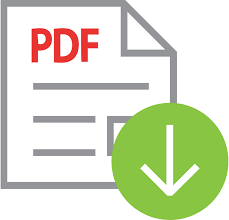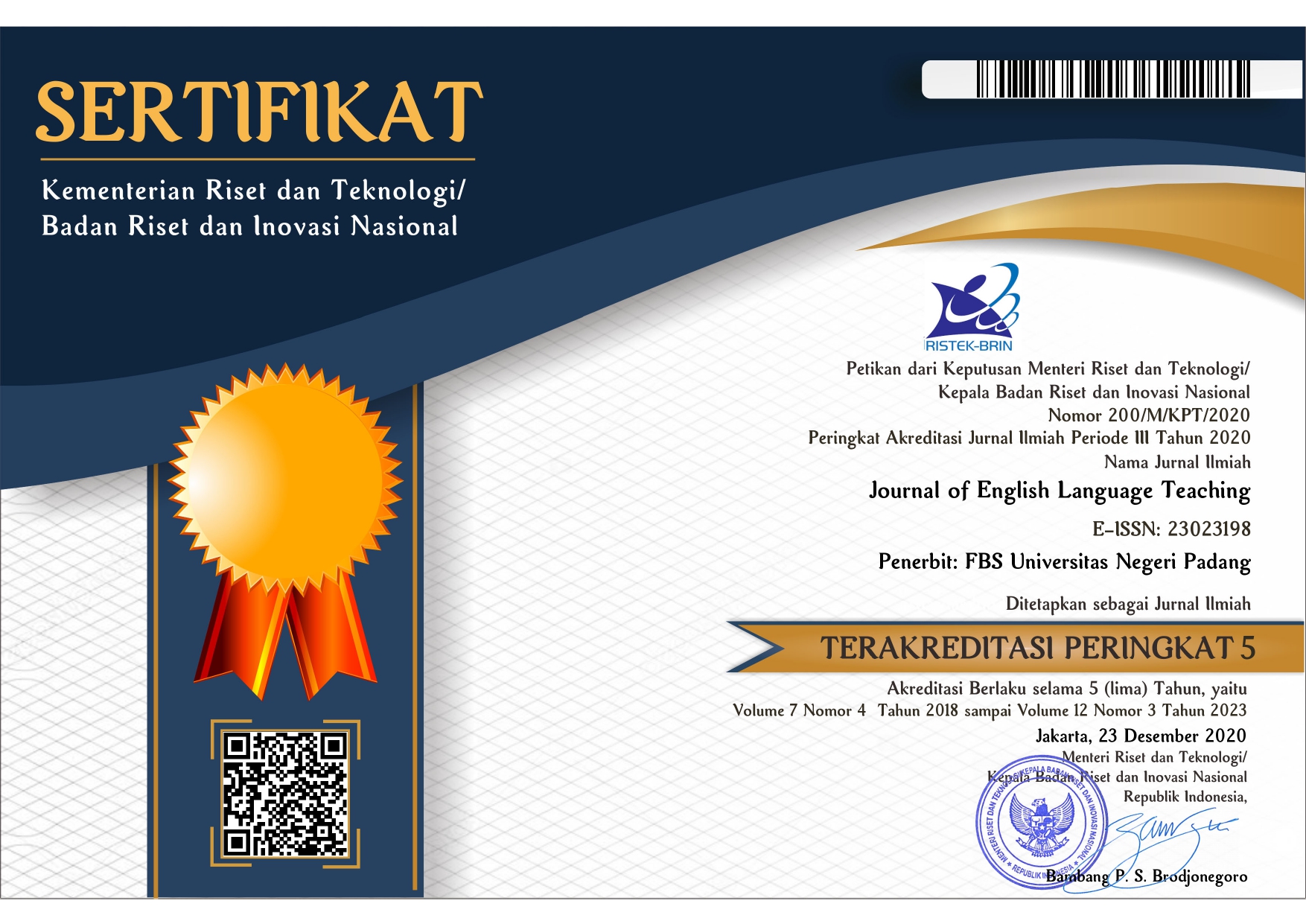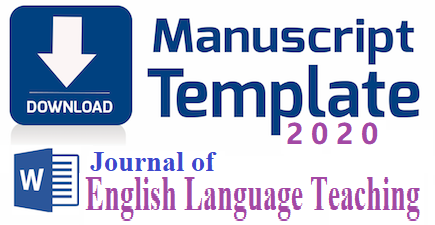English Teachers’ Challenges in Managing Classroom during Online Learning at SMAN 13 Padang
 ), Zul Amri(2),
), Zul Amri(2), (1) Universitas Negeri Padang
(2) Universitas Negeri Padang
 Corresponding Author
Corresponding Author
Copyright (c) 2023 Chindy Selvia, Zul Amri
DOI : https://doi.org/10.24036/jelt.v12i1.121665
Full Text:
 Language : en
Language : en
Abstract
Keywords
References
Alam, A. (2020). Challenges and Possibilities of Online Education during Covid-19.
Algahtani, A.F. (2011). Evaluating the Effectiveness of the E-learning Experience in Some Universities in Saudi Arabia from Male Students' Perceptions, Durham theses, Durham University
Allen, I. E. & Seaman, J. (2007). Online nation: five years of growth in online learning. Needham: Sloan Consortium
Allen, I. E., & Seaman, J. (2007). Online Nation: Five Years of Growth in Online Learning. Newburyport, MA.: ERIC
Almosa, A. (2002). Use of Computer in Education, (2nd ed), Riyadh: Future Education Library. E-learning Foundations and Applications, Saudi Arabia: Riyadh.
Amelia, F. (2022). EFL Online Classroom Management in COVID-19 Pandemic. Syarif Hidayatullah State Islamic University. Jakarta.
Badriah, S. (2019). Teachers’ Challenges in Classroom Management in Teaching English at Mas Mahdaliyah Jambi. Jambi.
Bower, M. (2006). Virtual classroom pedagogy. In Proceedings of the 37th SIGCSE technical symposium on Computer science education (SIGCSE '06) (pp.148-152). New York: ACM.
Braun, V., & Clarke, V. (2006). Using thematic analysis in psychology. Qualitative research in psychology, 3(2), 77-101.
Brown, James Dean. (1995). The Elements of Language Curriculum. Boston: Heinle and Heinle Publisher.
Budiman, Haris. 2017. The Role of Information and Communication Technology in Education. Lampung: Raden Intan State Islamic University, Lampung. (Journal of Islamic Education. Volume 8: 75-83)
C. M. Evertson & C. S. Weinstein (Eds.), Handbook of classroom management: Research, practice, and contemporary issues, 407-438. Mahwah, NJ: Lawrence Erlbaum Associates.
Chandra, R. (2015), “Classroom management tools for effective teaching,” Int. J. Educ. Psychol. Res., vol. 4, no. 4, pp. 13–15”.
Chou, C. (1999). Developing hypertext-based learning courseware for computer networks: The macro and micro stages. IEEE Transactions on Education, 42(1), 39-44. http://dx.doi.org/10.1109/13.746333
Chun, D., Kern, R., & Smith, B. (2016). Technology in language use, language teaching, and language learning. The Modern Language Journal, 100, 64-80.
Corps, Pace. (2020. Classroom Management. New York: Washington Dc.
Curran, K. (2002). A web-based collaboration teaching environment. IEEE Multimedia, 9(3), 72-76. http://dx.doi.org/10.1109/MMUL.2002.1022860
Dabbagh, N., & Bannan-Ritland, B. (2005). Online Learning: Concepts, Strategies, and Application. Upper Saddle River, NJ.: Pearson/Merrill/Prentice Hall.
Djaali., Pudji M. (2008). Pengukuran dalam Bidang Pendidikan. Jakarta: PT. Grasindo.
Djamarah, S., & Zain, A. (2010). Strategi Belajar Mengajar. Jakarta: Rineka Cipta. Hadad, C. (2006). Practical Tips for Teaching Large Classes. Bangkok: UNESCO Asia Fasific Regional Bureau for Education.1, 20. http://unesdoc.unesco.org/images/0014/001488/148867e.pdf.
Efriana, Leli. 2021. Problems of Online Learning during Covid-19 Pandemic in EFL Classroom and the Solution. Journal of English Language Teaching and Literature Volume 2, Number 1, February 2021, pages 38-47. Universitas Islam Labuhan Batu.
European Commission (2001). The eLearning Action Plan: Designing tomorrow’s education. http://www.elearningeuropa.info.
Evertson, C. M., & Weinstein, C. (2006). Classroom management as a field of inquiry. Handbook of classroom management: Research, practice, and contemporary issues (pp. 3-15). Mahwah, NJ: Lawrence Erlbaum Associates.
Fry, K. (2001). E-Learning Markets and Providers: Some Issues and Prospects. Education and Training, 43(4), 233.
Gabriel, M. (2004). Learning together: Exploring group interactions online. Journal of Distance Education, 19(1), 54-72. http://www.jofde.ca/index.php/jde/article/view/105/90
Garrett, T. (2014). Effective Classroom Management: the Essentials. New York: Columbia University.
Haddad, Caroline. (2006). Practical Tips for Teaching Large Classess: A Teacher’s Guide. Bangkok : UNESCO. 18.
Hoang, et. al (2021). EFL Teachers’ Perceptions and Challenges on Online Classroom Management during Covid-19 Pandemic.
Hsu, S., Marques, O., Khalid Hamza, M. &Alhalabi, B. (1999). How to design a virtual classroom: 10 easy steps to follow. T.H.E. Journal, 27(2), 96-109. http://www.eric.ed.gov/ERICWebPortal/contentdelivery/servlet/ERICServlet?accno=ED437027
Jones, L. (2007). The Student-Centered Classroom. New York : Cambridge University Press. 7
Larson, M. J. (1992). Teaching English As A Foreign Language To Large, Multilevel Classes. USA : Peace Corps.
Lasari, Yufi Latmini. (2021). Online Learning Classroom Management during the Covid-19 Period at PGMI IAIN Batusangkar. Jurnal Kepemimpinan dan Kepengurusan Sekolah Vol. 6, No. 1.
Lathifah, et. al (2020). The Practice of Effective Classroom Management in COVID-19 Time. International Journal of Advanced Science and Technology Vol. 29, No. 7, pp. 3263-3271
Liaw, S.S., Huang, H.M. (2003). Exploring the World Wide Web for on-line learning: a perspective from Taiwan. Educational Technology 40(3): 27–32.
Liaw, S.S., Huang, H.M. (2007). Developing a Collaborative e-learning System Based on User’s Perceptions. Lecture Notes in Computer Science, 4402, 751-759.
Liu, Y. (2015). Design and Application of a Virtual Classroom System in Major Courses in Industrial Arts. Anshan, China. iJET. Volume 10, Issue 5.
Mahyoob, M. (2020). Challenges of e-learning during the covid-19 pandemic experienced by EFL learners. Arab World English Journal, 11(4)
Manea, C. N., Negut, O. G. (2021). When “Face-To-Face” is no Longer an Option: Classroom Management Challenges during the Covid-19 Pandemics. Educational Challenges, Vol. 26, Issue 2
Margarita Kiseleva and Victoria Pogosian. (2021). Virtual Classroom. Herzen State Pedagogical University of Russia 48 Moika Embankment, Saint Petersburg, Russia.
Marzano, R. J., Marzano, J. S., & Pickering, D. J. (2003). Classroom Management That Works. Research-Based Strategies for Every Teacher, New York: Pearson Education
McCreay, R. (2013). Classroom Management. In EHow.
Nurhijjah. (2019). “Classroom Management used by English Teachers’ In Teaching English at SMA N 1 Bantaeng”. Teacher Training and Education. English Education Department. Universitas Muhammadyah. Makassar.
Oblinger, D. G., & Hawkins, B. L. (2005). The myth about E-learning. Educause review
Pianta, R. C., Hamre, B. K., & Mintz, S. (2012). Classroom assessment scoring system: Secondary manual. Teachstone.
Prabawati, Sukma B. A (2021). Problems Faced by English Teachers in Teaching English Online during Pandemic Covid-19 at SMP N 2 Kedunggalar.
Robert G. Harrington, R. G, Holub, L. (2006). Clashing Views On the Controversial Issues in Classroom Management. USA : McGraw Hill/Dushkin, 146.
Rufai M. M., Alebiosu S. O., Adeakin O. A. S. (2015). A Conceptual Model for Virtual Classroom Management. International Journal of Computer Science, Engineering and Information Technology (IJCSEIT), Vol. 5,No.1
Scrivener, J. (2005). Learning Teaching: A Guidebook for English Language Teacher 2nd ed. Malaysia : Macmillan Education, 86.
Setyani, F. E. (2021). Online Classroom Management Strategies of English Teacher during Covid-19 in a Public High School. Yogyakarta.
Sianipar, D. et. al (2021). Classroom Management of Christian Religious Education During the Covid-19 Pandemic. Budapest International Research and Critics Institute-Journal (BIRCI-Journal) Volume 4, No 4, November 2021, Page: 7585-7596
Sibarani, S. (2017). English Teachers' Strategies in Managing a Large Class. (Thesis Proposal). University of Jambi.Science.
Slavin, Robert E. (1994). Educational Psychology Theory and Practice (United States of America : John Hopkins University, 404
Stewart, D. (2008). Classroom management in the online environment. Journal of online learning and teaching, 4(3), 371-374
Sugiyono. 2005. Memahami Penelitian Kualitatif. Bandung: CV. Alfabeta.
Thiel, F., Richter, S. G., & Ophardt, D. (2012). Steuerung von Übergängen im Unterricht. Zeitschrift Für Erziehungswissenschaft, 15(4), 727–752
Tomlinson, B. (2010). Principles of effective materials development. In N. Harwood (ed.), English languageteaching materials (pp. 81-108). NY: CUP.
Wagner, N., Hassanein, K. & Head, M. (2008). Who is responsible for E-learning in Higher Education? A Stakeholders’ Analysis. Educational Technology & Society, 11 (3), 26-36.
Wahyuni, N. C. (2013). Classroom management done by the tutor of uefa course in teaching English at the first grade of SDN Kasin Malang. Undergraduate Theses of English Language of Education Department, University of Muhammadiyah Malang.
Wong, H., Wong, R., Rogers, K., & Brooks, A. (2012). What is Classroom Management. Managing classroom For Your Success, 4, (15), 1-61.
Yang, Z. & Liu, Q. (2007). Research and development of Web-based virtual online classroom. Computers & Education, 48(2), 171-184. http://dx.doi.org/10.1016/j.compedu.2004.12.007
Yolandasari, Mega Berliana. (2020). Effectiveness of Online Learning in Indonesian Language Learning in Class IIA Featured MI Miftahul Huda Tumang Cepogo Boyolali Academic Year 2019/2020. Thesis: Madrasah Ibtidaiyah Teacher Education Study Program, Faculty of Tarbiyah and Teacher Training, Salatiga State Islamic Institute 2020
Zamani, R. (2016). Characteristic of an Effective English Language Teacher as Perceived by Learners of English. International Journal of Foreign Language Teaching & Research, Vol 4, Issue 14.
Zeitoun, H. (2008). E-learning: Concept, Issues, Application, Evaluation, Riyadh: Dar Alsolateah publication.
 Article Metrics
Article Metrics
 Abstract Views : 386 times
Abstract Views : 386 times
 PDF Downloaded : 95 times
PDF Downloaded : 95 times
Refbacks
- There are currently no refbacks.
Copyright (c) 2023 Chindy Selvia, Zul Amri

This work is licensed under a Creative Commons Attribution-NonCommercial 4.0 International License.
















